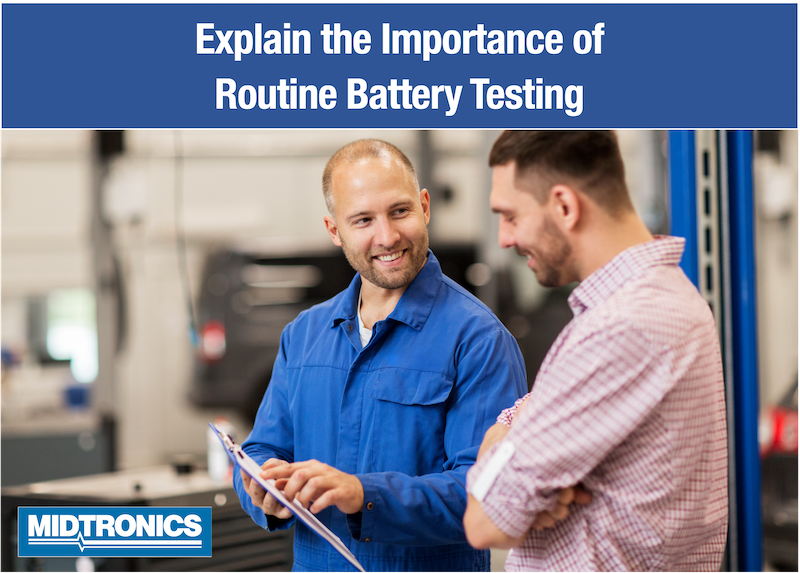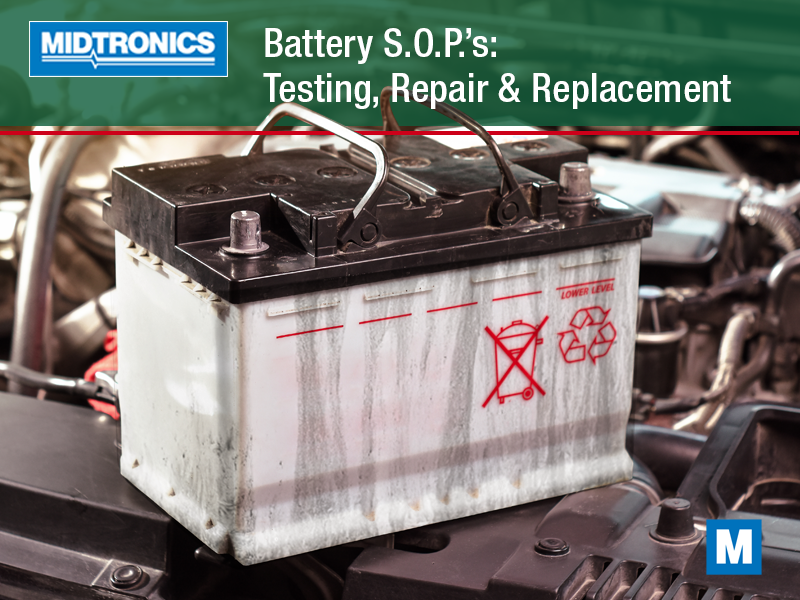If you’re at the service desk in a dealership or an independent repair shop, odds are good that you’ve had a customer ask you, “Why are you testing my battery?” or simply tell you, “There’s no need to check my battery condition.” The practice is commonplace industry-wide now, and it’s meant to be a positive thing that’s being done for the customer as well as help mitigate the shop’s responsibility for an unexpected failure.
But what can a service advisor, shop foreman, or service manager tell the customer when they quizzically ask about it or push back on the practice? Here’s what can help.
Routine Testing in the Customer’s Presence Is About Trust
One of the best practices to get into with battery tests is performing them in the customer’s presence while they’re checking their vehicle in. It takes just moments, and it’s an action that can do wonders for the trajectory the conversation will take. That’s because testing a battery with your customer during the walkaround shows that you’re trustworthy and consistent – and you can tell your customer that!
When they know that every time their car comes into your service drive thru that a factory-trained employee will be connecting cables from the handheld tester to the battery posts, they know you’re looking after them. And 9 times out of 10, the result will be that the battery is in good shape with nothing required – except terminal cleaning, perhaps. That consistency is something they look for, and if you miss it even once on vehicle check-in, they will notice.
Battery Condition Can Change Rapidly
A customer may bring their vehicle in on Monday for an engine diagnosis and have their battery tested. Then, when parts arrive for the repair and they come back Thursday of the same week, it seems unnecessary to test the battery again. Not only does it prove consistency with the little things, but battery condition can change quickly – even in just a few days.
A quick and easy explanation is to indicate all the factors that influence battery health: temperature fluctuations, driving habits, electrical system demands, and impacts or vibrations, for example. It’s not likely that there’s a difference since their visit from days ago, but it’s possible. Wouldn’t they like to be sure that nothing has changed?
Extreme Temperatures Affect Battery Performance
For most places in the world, weather conditions can change in an instant from sunny and beautiful to blustery and frigid – and often in the span of hours! Both hot and cold weather can have a significant impact on battery performance and lifespan. Heat accelerates chemical degradation inside the battery, while cold temperatures can reduce its ability to deliver the necessary power to start the engine. Frequent testing ensures the battery is performing as it should in all conditions.
New Batteries Can Fail Too
Every service technician and service advisor can point to a vehicle that’s under a year old, or a replacement battery that’s been installed less than 12 months prior, where it’s come in with a dead battery on the back of a tow truck. In rare instances, new vehicles have had a battery replacements during their new vehicle prep, just days after being dropped off at the dealership. It’s a fallacy that every battery has at least a three-year lifespan, and it’s easy to point out one or two of these situations to a customer if they wonder why their one-year-old vehicle – or brand new car – is getting its battery tested. Plus, it’s a great baseline to refer to for future tests if you want to determine how much it’s degraded.
Unexpected Battery Failures Are Inconvenient and Costly
Four out of five roadside assistance calls being for a dead battery, and that likely isn’t a shock to any vehicle owner or service personnel. And while the average lead-acid battery is far from the most expensive repair that could be performed, most newer cars have more expensive EFB or AGM batteries under the hood. Or, in the case of EVs and hybrids, it’s possible it’s a Lithium-Ion battery that’s even more expensive than an AGM one.
So, a quick question to ask a customer who pushes back about battery tests performed every time a vehicle comes in for service is this: “What would it cost you to have your battery fail unexpectedly? And what if this free step could help you avoid that expense?” What often gets overlooked is that a battery failure usually goes further than the purchase price of a new battery, and even past the installation cost. There’s time missed at work, a dinner reservation that you can’t get to, daycare late fees for missing the pickup deadline, and the cost of a call to emergency roadside assistance. Costs add up, and sometimes, the battery itself is the least of it.
Modern Vehicles Have Higher Electrical Demands
Today’s vehicles come equipped with advanced electronics, from infotainment systems and driver-assist technologies to complex engine management systems. These electrical demands put additional strain on the battery, well beyond what older vehicles used to bear. However, many vehicles have standard lead-acid batteries that aren’t proportionately larger in capacity or more robust than they were a decade or two ago when vehicles were less advanced, which could make them more susceptible to degradation or failure.
What can be done is simple: test the battery often. With routine monitoring, it’s possible to detect when the battery’s health begins to take a turn, and it can be headed off proactively with either servicing or replacement before it becomes a serious issue.
Keep Up with Battery Tests on Every Visit
All of these items can be relayed to customers who want to know about why you do what you do with battery tests at check-in. Questions arise from vehicle owners from time to time, and it can feel like an unnecessary step sometimes. But performing a battery test on every vehicle every time it’s in for service is a solid strategy that results in not just battery sales, but increased customer loyalty and satisfaction and fewer unexpected battery failures.




